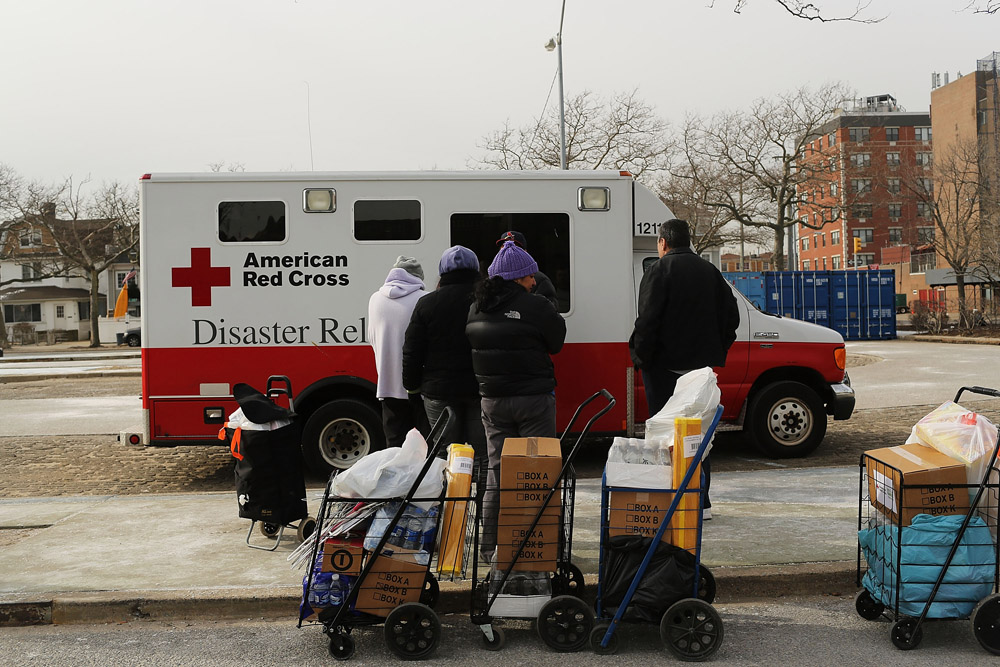
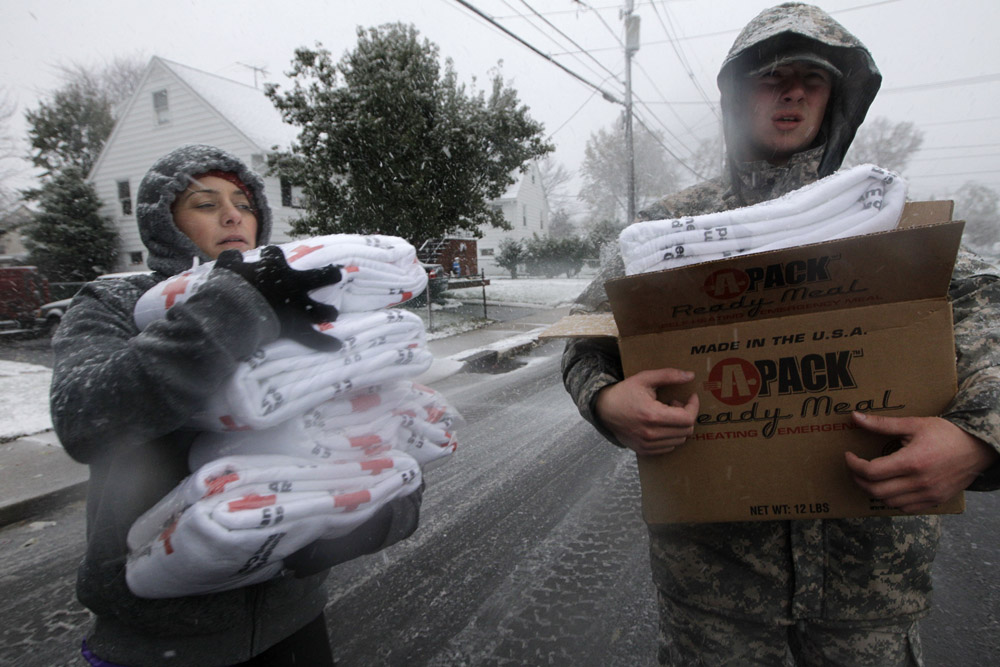
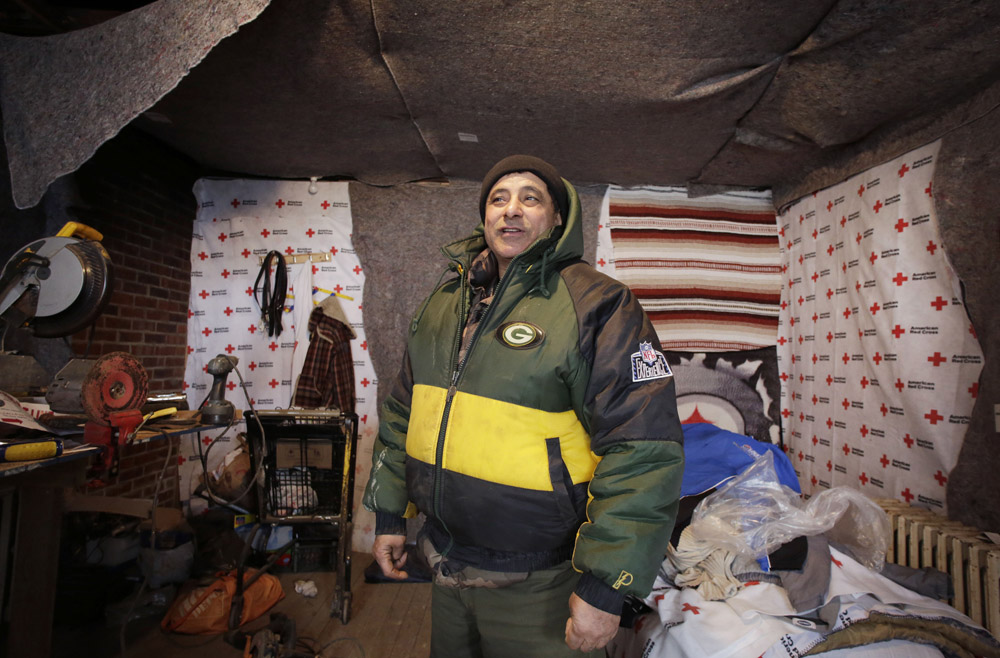
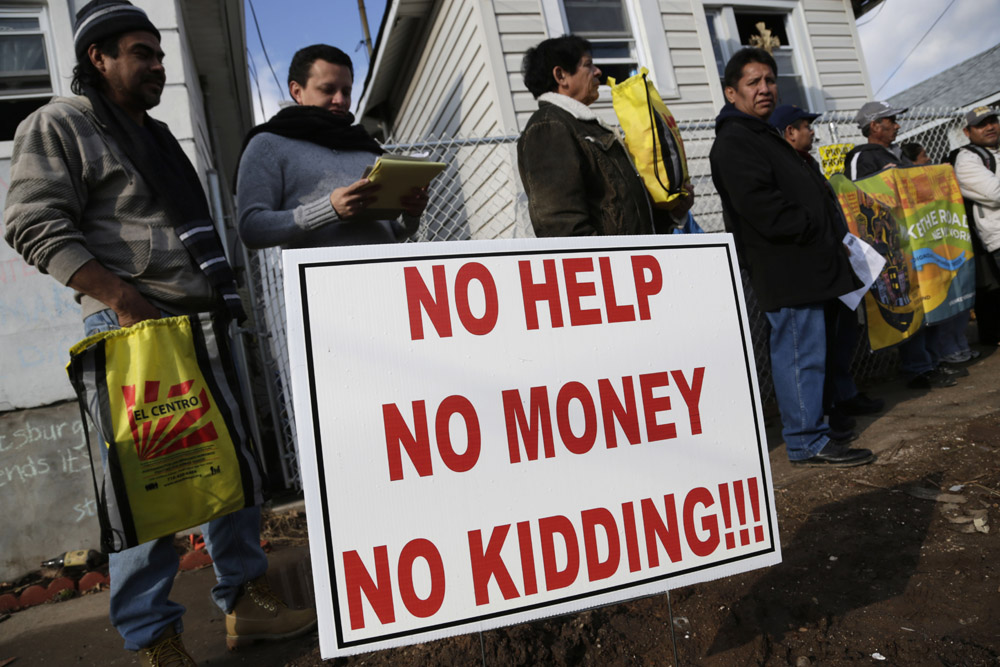
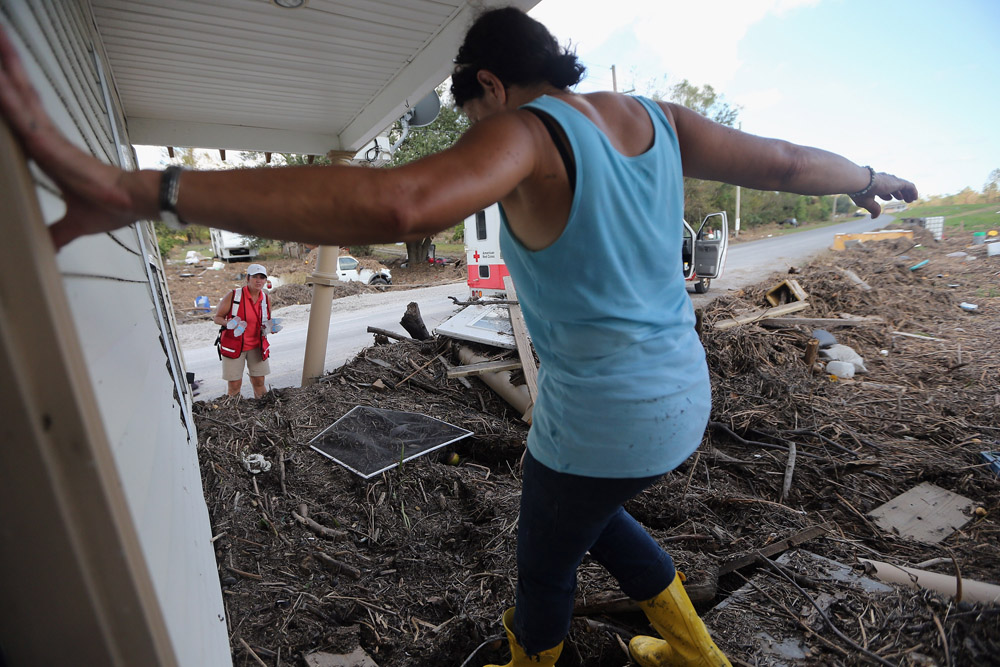
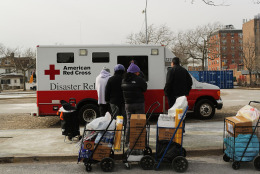
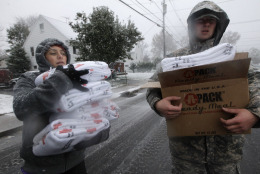
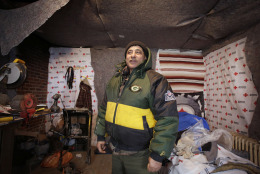
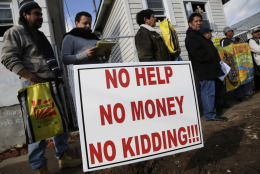
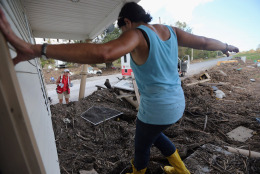
by Justin Elliott and Jesse Eisinger, ProPublica, and Laura Sullivan, NPR
In 2012, two massive storms pounded the United States, leaving hundreds of thousands of people homeless, hungry or without power for days and weeks.
Americans did what they so often do after disasters. They sent hundreds of millions of dollars to the Red Cross, confident their money would ease the suffering left behind by Superstorm Sandy and Hurricane Isaac. They believed the charity was up to the job.
They were wrong.
The Red Cross botched key elements of its mission after Sandy and Isaac, leaving behind a trail of unmet needs and acrimony, according to an investigation by ProPublica and NPR. The charity’s shortcomings were detailed in confidential reports and internal emails, as well as accounts from current and former disaster relief specialists.
What’s more, Red Cross officials at national headquarters in Washington, D.C. compounded the charity’s inability to provide relief by “diverting assets for public relations purposes,” as one internal report puts it. Distribution of relief supplies, the report said, was “politically driven.”
During Isaac, Red Cross supervisors ordered dozens of trucks usually deployed to deliver aid to be driven around nearly empty instead, “just to be seen,” one of the drivers, Jim Dunham, recalls.
“We were sent way down on the Gulf with nothing to give,” Dunham says. The Red Cross’ relief effort was “worse than the storm.”
During Sandy, emergency vehicles were taken away from relief work and assigned to serve as backdrops for press conferences, angering disaster responders on the ground.
After both storms, the charity’s problems left some victims in dire circumstances or vulnerable to harm, the organization’s internal assessments acknowledge. Handicapped victims “slept in their wheelchairs for days” because the charity had not secured proper cots. In one shelter, sex offenders were “all over including playing in children’s area” because Red Cross staff “didn’t know/follow procedures.”
According to interviews and documents, the Red Cross lacked basic supplies like food, blankets and batteries to distribute to victims in the days just after the storms. Sometimes, even when supplies were plentiful, they went to waste. In one case, the Red Cross had to throw out tens of thousands of meals because it couldn’t find the people who needed them.
The Red Cross marshalled an army of volunteers, but many were misdirected by the charity’s managers. Some were ordered to stay in Tampa long after it became clear that Isaac would bypass the city. After Sandy, volunteers wandered the streets of New York in search of stricken neighborhoods, lost because they had not been given GPS equipment to guide them.
The problems stand in stark contrast to the Red Cross’ standing in the realm of disaster relief. President Obama, who is the charity’s honorary chairman, vouched for the group after Sandy, telling Americans to donate. “The Red Cross knows what they’re doing,” he said.
Two weeks after Sandy hit, Red Cross Chief Executive Gail McGovern declared that the group’s relief efforts had been “near flawless.”
The group’s self-assessments, drawn together just weeks later, were far less congratulatory.
“Multiple systems failed,” say minutes from a closed-door meeting of top officials in December 2012, referring to logistics. “We didn’t have the kind of sophistication needed for this size job,” noted a Red Cross vice president in the same meeting, the minutes say.
Red Cross officials deny the group had made decisions based on public relations. They defend the Red Cross’ performance after Isaac and Sandy.
“While it’s impossible to meet every need in the first chaotic hours and days of a disaster, we are proud that we were able to provide millions of people with hot meals, shelter, relief supplies and financial support during the 2012 hurricanes,” the charity wrote in a statement to ProPublica and NPR.
The Red Cross says it has cultivated a “culture of openness” that welcomes frank self-evaluation and says it has improved its ability to handle urban disasters. One reform, the Red Cross says, moved nearly one-third of its “disaster positions” out of national headquarters and into the field, closer to the victims.
But some Red Cross veterans say they see few signs the organization has made the necessary changes since Sandy and Isaac to respond competently the next time disaster hits.
Richard Rieckenberg, who oversaw aspects of the Red Cross’ efforts to provide food, shelter and supplies after the 2012 storms, said the organization’s work was repeatedly undercut by its leadership.
Top Red Cross officials were concerned only “about the appearance of aid, not actually delivering it,” Rieckenberg says. “They were not interested in solving the problem — they were interested in looking good. That was incredibly demoralizing.”
The modern-day Red Cross was created by congressional charter more than a century ago and plays a unique part in responding to disasters. The iconic charity has a government mandate to work alongside the Federal Emergency Management Agency in relief efforts.
The Red Cross has endured patches of trouble in the recent past. It faced allegations of financial mismanagement after Sept. 11 and Hurricane Katrina and a series of chief executives were forced to resign. Congress forced an overhaul. The Red Cross recruited McGovern to the top job in 2008.
McGovern had spent her career as an executive at AT&T and Fidelity and was teaching marketing at Harvard Business School. “This is a brand to die for,” she said in an early interview as the Red Cross’ chief executive.
Indeed, the Red Cross remains a magnet for wealthy and corporate contributors, drawing more than $1 billion in donations last year, including at least $1 million each from Lady Gaga, Nicolas Cage and the oilman T. Boone Pickens.
When McGovern took the reins, she inherited a sprawling operation with hundreds of chapters across the country. The Red Cross has more than 26,000 employees. After a storm, the full-time staff mobilizes volunteers and a smaller corps of disaster relief experts, known as reservists.
While often praised as a stabilizing presence by those outside the Red Cross, McGovern initiated a series of changes inside the organization that roiled the venerable charity. She executed layoffs and reorganizations that closed local chapters and centralized power at national headquarters in Washington. In part, these changes reflected several years of operating in the red. In its most recent year, the Red Cross ran a $70 million budget deficit. “Fundraising fell short of our target in a year without any huge national disasters,” McGovern wrote in a September email to executives.
But McGovern’s moves alienated many longtime volunteers and reservists, current and former Red Cross officials say.
“I believe the reorganizations that have taken place are killing this organization,” says Bob Scheifele, a veteran Red Cross disaster response expert who was on the ground after Isaac and Sandy.
The Red Cross began to see the effects of McGovern’s changes in late August 2012, when Hurricane Isaac slammed into the Gulf Coast. The storm lingered over Mississippi and Louisiana, causing major flooding and more than $2 billion in damage. In some low-lying areas, residents had to be rescued from the rooftops of their submerged homes.
The Red Cross mobilized hundreds of volunteers, equipment, emergency vehicles and supplies. But it couldn’t marshal them promptly enough to help many Isaac victims.
When Rieckenberg arrived in Mississippi to help coordinate victim care, he witnessed the incident that so troubled Dunham, the emergency vehicle driver. An official gave the order to send out 80 trucks and emergency response vehicles — normally full of meals or supplies like diapers, bleach and paper towels — entirely empty or carrying a few snacks.
The volunteers “were told to drive around and look like you’re giving disaster relief,” Rieckenberg says. The official was anticipating a visit by Red Cross brass and wanted to impress them with the level of activity, he says.
The disarray and deception in Mississippi made Rieckenberg “furious,” he recalls. Rieckenberg, 62, had spent his career as a nuclear engineer on a Navy sub during the Cold War. He joined the Red Cross after seeing the images of Katrina’s devastation.
He was quickly promoted and became part of a select group of “Mass Care Chiefs.” In Red Cross lingo, “mass care” is the provision of food, shelter and supplies immediately after a disaster. When a serious storm was forecast anywhere in the country, Rieckenberg would get a call at his home outside Santa Fe and jump on a plane. Chiefs often work 18-hour days, setting up makeshift command centers in places like motel hallways, sometimes working without electricity. Jobs usually last a few weeks, beyond which chiefs risk burning out from exhaustion. As a reservist, Rieckenberg was paid small sums for responding to disasters.
The problems with the Red Cross’ response to Isaac began even before the storm hit. About 460 mass care volunteer workers — 90 percent of the workers the organization dispatched to provide food and shelter for the storm overall — were stationed in Tampa ahead of landfall, Rieckenberg’s emails from the time say.
The hundreds of volunteers in Tampa weren’t only there for the hurricane: The Republican National Convention was going on there and the Red Cross wanted a large presence, Rieckenberg says. The Red Cross typically deploys about 20 volunteers to such meetings.
Emails from the time show Rieckenberg complained that Red Cross officials prevented disaster response leaders from moving volunteers out of Tampa even after forecasts showed that the hurricane wouldn’t hit the city. It was the first time in Rieckenberg’s experience that people in charge of disaster relief didn’t have the final say over where Red Cross volunteers were sent.
The Red Cross disputes the notion that the Republican National Convention influenced their deployment, saying it was responding to early forecasts that Tampa might be in Isaac’s path.
“There was nothing political in our decisions regarding Tampa,” the charity says. “We would have made the same decisions if it had been a convention of chiropractors.”
But according to the National Hurricane Center, at least five days before Isaac made landfall it was clear the storm would not hit Tampa.
The charity also insists that “the volunteers and resources we deployed to Florida did not come at the expense of other states.” It did not provide figures for how many mass care volunteers were on the ground in other states before Isaac.
Whatever the reason the Red Cross sent so many volunteers to Tampa, a number of Red Cross officials say there were delays in getting them out. “After how long they were in Tampa, they obviously could not redeploy. They consumed all their available time and went home,” says Bob Scheifele, who served as mass care chief in Louisiana. A former major in the Army, Scheifele was so upset after Isaac that he drafted a resignation letter, though he ultimately decided not to send it.
The overall Red Cross operation after Isaac was beset by problems. Rieckenberg emailed his superior at national headquarters on Sept. 12, 2012, to sound the alarm. “In Mississippi we were unable to open a single shelter with proper staff, materials and food resources prior to landfall,” Rieckenberg wrote. “We had trouble getting food to our kitchens.” The Red Cross’ relief efforts were “marked primarily by internal political wrangling, power struggles and ineffectiveness.”
“You (as usual) have clearly articulated the core of many of the issues we are facing. From a broad perspective I completely agree with you,” Trevor Riggen, the top Red Cross disaster response official, replied that same day. “This is extremely systemic.”
He also praised Rieckenberg for his service: “You have been an extraordinary asset to the country,” Riggen wrote.
In mid-October 2012, Rieckenberg and Scheifele traveled to Washington to present their experiences to Riggen and two other high-level Red Cross executives.
“We are more enamored with the perception of success rather than success,” Rieckenberg told them, according to his notes. He and Scheifele presented a host of other concerns to the officials.
The executives asked Rieckenberg and Scheifele to be patient, promising reforms.
And then, on Oct. 29, 2012, Sandy hit New York.
The superstorm was the worst to hit the northeast in a generation. In addition to President Obama, Mitt Romney and Bruce Springsteen urged people to donate to the Red Cross. The charity ultimately raised $312 million to help Sandy victims. (ProPublica has raised questions about the opacity of Red Cross disclosures on how this money was spent.)
But while its fundraising was torrential, its disaster response was a trickle.
“The Red Cross would have been helpful if it had offered food, water, shelter, cleaning supplies, blankets,” says Rich Wieland, whose house in Toms River, New Jersey was flooded and whose neighborhood lost power for 16 days. His first contact with the charity came two months after the storm when Red Cross workers finally called to offer aid. “It was too little, too late.”
Richard Sturiale, who saw the basement and first floor of his home in the Rockaways destroyed by flooding, recalls that “the only Red Cross truck my neighbors or I saw came two weeks after the storm.” In contrast, he says, Mormon and Amish volunteers “appeared at my doorstep offering much-needed help” just three days after Sandy.
Behind closed doors, Red Cross executives acknowledged the effort was falling short. The charity was “not good at scaling up” to the size of the disaster, said the official in charge of the Red Cross disaster response in New York, according to the minutes of the December 2012 meeting to assess the charity’s performance. Among the multiple systems that “failed” was the charity’s tracking of its emergency response vehicles.
Again, top officials impeded the organization’s relief efforts in their zeal to burnish its public profile. An internal “Lessons Learned” PowerPoint presentation lists “hindrances to service delivery.” Its first bullet point: “NHQ” – national headquarters. Under that, it lists one of the problems as “diverting assets for public relation purposes.”
Rieckenberg, who planned the Red Cross’ mass care effort from Washington before the storm hit and then worked on the ground in New York, experienced the problem firsthand. In early November, the Red Cross had a limited number of emergency response vehicles, or ERVs, active in the New York City area.
But multiple officials complained that the vehicles, a crucial part of the relief efforts, were being tied up at press conferences. On Nov. 2, 2012, at the peak of the post-storm crisis, 15 were assigned to public relations duties, Rieckenberg says. Meanwhile, Sandy victims in neighborhoods along the beaches like the Rockaways couldn’t get food and drinkable water. Rieckenberg documented his concerns in an email on Nov. 18, 2012, to Riggen, the Red Cross executive in charge of disaster operations, and later mentioned it in a December email to other top Red Cross disaster volunteers.
Another Red Cross disaster response chief, Steve Ade, complained to a vice president, according to Rieckenberg and two other Red Cross officials.
“I can’t afford to have my ERVs sitting around all morning,” Ade said.
“Stop right there,” a Red Cross executive from headquarters responded. “These are not your ERVs. They belong to Gail and she’s going to do whatever she wants with them,” referring to McGovern, the Red Cross chief executive.
In a statement, the Red Cross denied that emergency response vehicles were “dedicated” to public relations duties. The charity said 15 vehicles were distributing supplies at a site in Staten Island where a press conference with then-Secretary of Homeland Security Janet Napolitano was held. Rieckenberg says this was 40 percent of all available ERVs; the Red Cross says that’s wrong but could not say how many ERVs were in New York that day.
The vehicles had been sent to Staten Island at the request of the borough president “to address needs in that area,” the charity says. According to the Red Cross, Chief Executive McGovern “participated in the press conference, but Red Cross did not hold the press conference and, to be clear, it was not the reason that ERVs were sent to Staten Island.” (The Red Cross did issue a press release for the event, stating that McGovern would have a “media availability.”)
In another diversion, an emergency response vehicle was dispatched to an early December photo-op with supermodel Heidi Klum to tour affected areas with Red Cross supplies, recalled a third senior Red Cross official who requested anonymity because the official still works for the charity. “Did you know it takes a Victoria’s Secret model five hours to unload one box off a truck?” the official says. “I was so mad.”
The Red Cross says Klum was delivering supplies to families.
At the same time emergency vehicles were assigned to public relations duties, the Red Cross was having problems in many other parts of the relief effort, according to the “Lessons Learned” presentation.
Among the more worrisome instances had to do with sex offenders. Red Cross officials are supposed to track sex offenders who come to shelters and confer with law enforcement. But staff “didn’t know/follow procedures,” the presentation notes. There was an additional problem with “ unrelated adults showering with children.”
“It’s hard for us to know based on this document exactly what occurred and where,” the charity wrote in a statement. “The Red Cross has a humanitarian responsibility to provide safe shelter to all people who seek refuge in our facilities and has policies and procedures to handle a wide array of situations, including the presence of sex offenders in shelters.”
More generally, in response to questions from ProPublica and NPR about the “Lessons Learned” presentation, the Red Cross wrote, “Some of the issues were corrected immediately during the response, others we are taking additional steps to improve.”
During the Sandy disaster, some government officials came to resent the Red Cross.
When the storm hit, officials in Bergen County, New Jersey activated their Emergency Operations Center. In keeping with a carefully established plan, representatives from government agencies and charities gather there to coordinate, share information and respond to crises 24 hours a day.
A seat was reserved for the Red Cross, the most important nongovernment responder. But the Red Cross’ seat remained empty for the full duration of the Sandy response.
“They were the only major player not there,” says police lieutenant Matthew Tiedemann, who helped run Bergen County’s response to Sandy. County officials had no easy way to get in touch with Red Cross leadership to tell them about areas of need on the ground, he says.
Turnover and reorganizations appear to have had a corrosive effect on the Red Cross’ effectiveness. The “ biggest challenge,” one top Red Cross official said in the December 2012 meeting, is the “skillset that is possessed by our workforce.” Another was even more stark: The “ caliber of the people is a major issue (this is not a training issue),” according to the meeting minutes.
The Red Cross acknowledges that nearly two-thirds of the volunteers responding to Sandy had never before provided relief after a large disaster.
Some of the Red Cross’ Sandy volunteers were hindered not only by their lack of experience or skills but by their advanced age. As the Red Cross’ internal documents note, the challenges of urban disaster response include physically grueling tasks such as walking up stairs in high rises to get to people in need.
“You’ve got a 75-year-old emergency response vehicle driver who’s got to go up 17 stories to feed a 75-year-old disaster victim. You can’t do that,” bemoaned one top Red Cross official who was on the scene in New York.
Relief workers for other groups often found the Red Cross’ efforts ineffectual and at times even “absurdist,” says Sofía Gallisá Muriente, a volunteer for the relief group Occupy Sandy. She started working in the Rockaways a couple of days after the storm hit and stayed for 10 months.
When the Red Cross finally appeared weeks after the storm, volunteers were planning to distribute flashlights but discovered they had no batteries, she says. One Red Cross staffer came to a Rockaways community center and asked them to donate some. “I was infuriated,” she recalls. “Didn’t Lady Gaga just donate a million dollars to you guys?” she asked the Red Cross staffer. “Buy some batteries with it.”
Bringing volunteers from places like Kansas and North Carolina to New York City, in some cases for the first time, led to problems. Muriente and others recall that Red Cross workers got lost driving around New York without GPS devices, trying to find devastated neighborhoods. In one previously unreported incident that became instantly notorious among Sandy responders, the Red Cross brought a truck full of pork lunches to a Jewish retirement high-rise.
In the ensuing chaos, the caterer was only able to deliver 70,000 Danishes the following day, Rieckenberg says. The cost to the Red Cross: about $7 apiece, much more than normal. Top Red Cross officials had assured Rieckenberg that someone would get him the locations where staffers could deliver the meals. The list was never supplied. About half of the pastries were wasted. The caterer couldn’t produce the lunches and dinners. Red Cross volunteers had to distribute cold leftover Danishes instead.
“We were pushing every resource we had to its maximum capability,” Riggen, the Red Cross executive, said when asked about the episode.
In response to questions about its performance after Sandy overall, the Red Cross frequently points to the total number of services it says it delivered: 17 million meals and snacks, 74,000 overnight stays in shelters, more than 7 million relief items like blankets and flashlights.
However, one internal report casts doubt on the reliability of these figures: The “sheer size” of the disaster “ crippled our ability to count” the number of relief items distributed, it says.
Asked about that, Riggen says “crippled” is “a strong term.” The public enumeration of the Red Cross’ services was accurate, he says.
The focus on public relations persisted throughout the Sandy operation. In early December 2012, Red Cross officials asked Bob Scheifele, who was then mass care chief for New York, to put on a demonstration for donors who had funded the Spirit of America, a giant mobile kitchen attached to a semi, which has the capacity to make 30,000 meals a day.
The Spirit of America had recently been shut down, as the need for meals was tapering off. Scheifele says he made the arrangements to have it restarted, but there was a snafu, and the Spirit of America didn’t get up and running properly.
Top Red Cross executives were furious. Scheifele says they demanded that he fire people under him. He was baffled by the reaction. They hadn’t failed to deliver disaster relief, after all. He says he refused, telling his superiors that if anyone should be let go, it should be him, since he was in charge. The Red Cross sent Scheifele home, dismissing one of its most senior disaster responders.
“Public relations became the issue. It was a dog-and-pony show,” Scheifele says. He has since reconciled with top executives and continues to work on disasters for the Red Cross, an organization he says he loves.
The Red Cross maintains that the Spirit of America was reopened to serve the community, not for donors. It declined to provide documentation for its account. Scheifele documented the incident at the time in a “ memo for the record.”
As he had after Hurricane Isaac, Rieckenberg brought his concerns to top Red Cross officials after Sandy. “We became focused on making ‘the numbers look good’ and in ‘showing a presence,’” he emailed Riggen, the Red Cross vice president, on Nov. 18, 2012. He described what happened when he advised his bosses that a suggested feeding plan wouldn’t help storm victims. “I was quite bluntly told that they didn’t care – it was the plan that was going to make the ARC [American Red Cross] look the best to the local politicians,” he wrote.
Riggen, the disaster official, pledged to call him the following week. Rieckenberg says he never heard from him.
Before he left New York, Rieckenberg finally was able to look up from his post, leave the relief operation center in Manhattan and get out to see Sandy’s destruction for himself. He encountered an older woman who was running a kitchen for the Southern Baptists. The Red Cross was supposed to be supplying the kitchen with propane, but the woman said it hadn’t arrived. She told him a group of volunteers scraped together $700 to get the supplies they needed.
“I felt so ashamed,” he says.
More recently, sitting on his patio in a small town in New Mexico, he says his experiences in Isaac and Sandy had permanently altered his view of an organization he had loyally served for years.
He was asked: Should people give money to the Red Cross? “I don’t donate to the Red Cross. People should do what they think is best for them.”
This story is reproduced by permission of ProPublica and originally appeared on ProPublica.org on Oct. 29, 2014. This story was co-produced with NPR. Theodoric Meyer contributed reporting.
Can you help ProPublica with their Red Cross investigation? Share a tip or join the ProPublica reporters this Friday for a live chat.
ProPublica is a Pulitzer Prize-winning investigative newsroom. Sign up for their newsletter .







